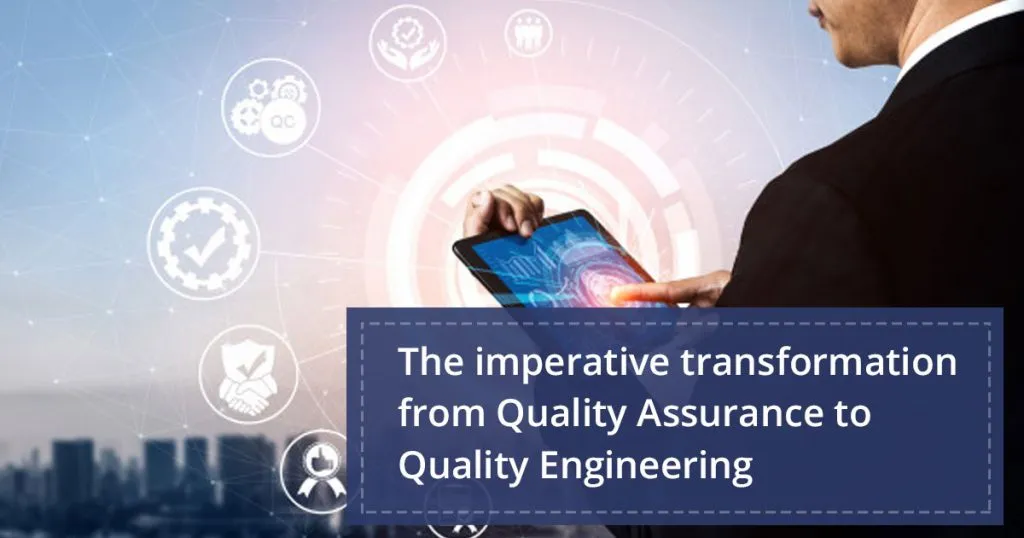The imperative transformation from Quality Assurance to Quality Engineering
Blog: NASSCOM Official Blog

Quality engineering has become imperative for organizations to adopt given the increased demand for quality in the entire span of the product development, testing, and deployment process.
The inscrutable march of technology continues taking convenience, quality, capability, scalability, and user experiences to a whole new level. Enterprises are looking at implementing new technological paradigms and tools to develop quality products and services, generate new revenue models, and stay competitive. As the technology landscape transforms at a rapid pace with the advent of technologies like Artificial Intelligence, Robotics, the Internet of Things, Predictive Analysis, Big Data, and many more, traditional models are no longer adequate. When the stakes are so high with driverless cars and IoT devices on their way to become the new normal, traditional software quality assurance services need to give way to quality engineering.
The quality engineering approach is about driving quality into the core of any software development process rather than following it along the way. This helps to reduce the possibility of errors/bugs to get into the system. Thus, quality engineering is more of a pre-emptive way of reducing glitches and ensuring the applications running the IT ecosystems of tomorrow are of proven quality. Further, the below-mentioned developments or observations highlight the predicament of following traditional software quality assurance services –
- About 30 percent of glitches or defects are due to wrongly configured test environments (Souce: an IBM study)
- Poor quality software leads to a loss of $60 billion annually in the USA
- Enterprises can save costs by optimizing the use of tools (Source: Gartner)
- Software testing comprises more than 50 percent of the development cost. This calls for automating the QA process and improving its effectiveness (Source: Journal of Systems and Software)
- Actual resource utilization for testing is about 57 percent instead of the expected 75 percent (Source: NIST Journal)
Why transform from quality assurance to digital quality engineering?
The benefits of switching to a robust, all-encompassing, and qualitatively superior QE services are as follows:
Driving the DevOps pipeline: DevOps envisions the marriage of development and operations to improve the quality of products and customer experiences on a continuous basis. Software quality engineering envelops DevOps by bringing the management, ideation, design, systems, product management, and operations together. It is a holistic approach to develop and deliver software applications that are safe, reliable, robust, secure, and scalable.
Maximum test coverage: In enterprise quality engineering, the entire span of the value chain (requirement to delivery) is covered in testing. It includes both shift-left and shift-right approaches of QA wherein the former testing is incorporated in the build phase itself. While in shift-right, quality is built into the delivery phase with continuous releases to ensure user satisfaction. Thus, software QE services cover the entire span of the SDLC including aspects like setting up and managing the test environments.
Powering CI/CD: DevOps is about developing and delivering software involving phases like build, test, and deployment. Here, every code change based on feedback from the QA team leads to faster integration and delivery in a transparent manner. The endless loop of feedback, code change, integration, and delivery ensures a better quality of products for the customer. Also, with the blurring of lines among departments and the initiation of a change in culture, quality is not merely the responsibility of the QA team alone but every stakeholder in the SDLC.
Better planning: There may be times when QA specialists identify an issue in the code requiring significant rework. This would lead to cost escalation and stretch the turnaround time. On the other hand, quality engineering services help in better planning at the initial stage of ideation and product development. They provide better insights to recognize limitations surrounding product implementation early on. Thus, identifying the potential glitches early in the development process can add to significant savings on cost and time.
Better communication: Digital quality engineering specialists can test a product like the end-users and draw traceability into the systems should some glitches be identified. Their knowledge about the whole span of product development, testing, and delivery, helps in understanding issues from the perspectives of the system and users. They can contribute to enhancing the processes within the SDLC for churning out top quality products at every stage and iteration.
Conclusion
With quality becoming the cornerstone of product development and ensuring competitiveness for an enterprise, the thrust is towards eliminating glitches during the planning stage only. This is why it is important to transition from QA to QE to facilitate quicker releases through the CI/CD pipeline and ensure superior customer experiences.
The post The imperative transformation from Quality Assurance to Quality Engineering appeared first on NASSCOM Community |The Official Community of Indian IT Industry.
